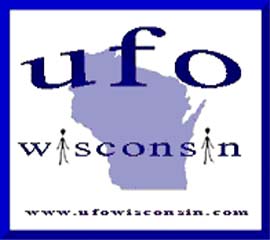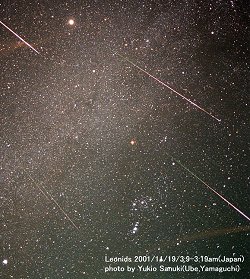 |
Home |
File a UFO Report |
View UFO Reports |
|
![]()
The 2003 Leonid Meteor Shower
An unusual double Leonid meteor shower is going to peak next month over parts of Asia and North America.
October 10, 2003: The Leonid meteor shower is coming. Twice.Bill Cooke of the Space Environments Group at the NASA Marshall Space Flight Center explains: "Normally there's just one Leonid meteor shower each year, but this year we're going to have two: one on Nov. 13th and another on Nov. 19th."
Both are caused by comet Tempel-Tuttle, which swings through the inner solar system every 33 years. With each visit the comet leaves behind a trail of dusty debris--the stuff of meteor showers. Lots of the comet's old dusty trails litter the mid-November part of Earth's orbit.
| Right: Leonid meteors over Japan in 2001. Photo credit: Yukio Sanuki. |  |
"Our planet glides through the debris zone every year," says Cooke. "It's like a minefield. Sometimes we hit a dust trail, sometimes we don't." Direct hits can spark a meteor storm, which is defined as more than 1000 shooting stars per hour. "That's what happened in, for example, 1966 and 2001," says Cooke. "Those were great years for Leonids."
"This year we're going to brush past two of the trails--no direct hits," he says. Even so, "we might have a nice display."
The first shower is expected on Nov. 13th around 17:17 UT. For about three hours centered on that time Earth will be close to some dust shed by Tempel-Tuttle in the year 1499. Sky watchers in Alaska, Hawaii and along the Pacific rim of Asia are favored. They'll see anywhere from a few to 40 meteors per hour--"if they can avoid the glare from that night's gibbous Moon," cautions Cooke. A good strategy for moonlit meteor observing: travel to high altitudes where the air is clear or stand in the shade of a tall building or hillside.
Curiously the Moon will be much closer to the 1499 trail than Earth will be. "If the Moon had an atmosphere to catch the comet dust, there would be about 1400 meteors per hour in lunar skies--a real storm," notes Cooke. Instead, the Leonids will simply hit the ground.
Most Leonid meteoroids are microscopic, and when they hit the Moon they do little more than raise a puff of moon dust. But a few will be bigger: the size of golf balls or grapefruits. Traveling about 160,000 mph, these impactors can cause explosions visible from Earth. (For more information about this, read the Science@NASA story Explosions on the Moon.)
| Right: A Leonid explosion on the Moon. David Dunham of the International Occultation Timing Association recorded the video in 1999. The flash is about as bright as a 3rd magnitude star. |  |
"This year we won't be able to see any lunar impacts," notes Cooke, "because most of the Leonids will strike the far side of the Moon. Some will hit the Earth-facing side, but the ground where they hit will be sunlit. That makes it very hard to see the explosions."
The second and more impressive shower arrives almost a week later on Nov. 19th when Earth approaches a trail shed in 1533. "Sky watchers up and down the US east coast will have the best view," says Cooke. "For a while around 07:28 UT (2:28 a.m. EST), they could see more than one meteor per minute." The Moon, a thin crescent on Nov. 19th, won't be bright enough to interfere with the display. (Nor will it be close to the cometary dust stream, so once again there will be no visible lunar explosions.)
Cooke assembled these forecasts using data from several researchers who have done a good job predicting Leonid storms in recent years: Peter Jenniskens at NASA's Ames Research Center, Jeremy Vaubaillon of the Institut de Mecanique Celeste et de Calcul des Ephemerides in France, and Esko Lyytinen. They mostly agree that Earth will encounter dust streams on Nov. 13th and 19th, but there is less consensus about how intense the resulting showers will be. Lyytinen, for instance, predicts a maximum of just 30 meteors per hour on Nov. 19th. Vaubaillon says 100.
Who's right? See for yourself. Be outside when the time comes, looking up.